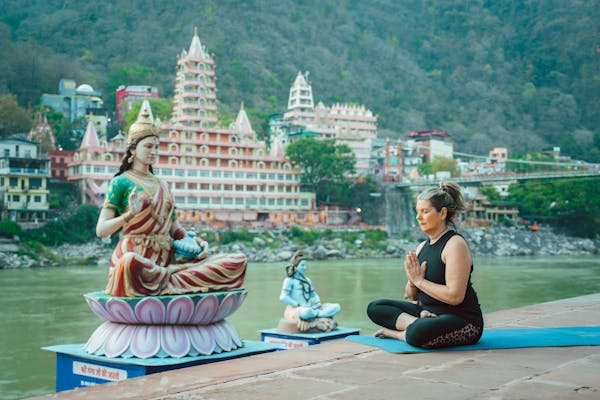Yoga blocks are an amazing tool that can transform your yoga practice by adding support, improving alignment, and helping you explore poses more deeply. Whether you’re just starting out or looking to challenge your flexibility and balance, yoga blocks offer the assistance needed to practice with confidence.
What Are Yoga Blocks?
Yoga blocks are sturdy rectangular props, typically made from foam, cork, or wood, designed to bring the floor closer to you during certain poses. They’re perfect for all levels because they help make challenging poses more accessible, ensuring proper alignment while reducing strain. By providing support, they enable you to hold poses longer, deepen stretches, and maintain stability.
Benefits of Using Yoga Blocks
- Support & Balance: Blocks offer stability in standing poses, helping you balance better.
- Deeper Stretches: They allow you to stretch further in poses like forward folds by elevating the floor or limbs.
- Enhanced Flexibility: Blocks let you maintain proper form while working toward increased flexibility.
How to Use Yoga Blocks in Key Poses
Using yoga blocks depends on the specific pose you’re working on. Let’s break down how to use them in common yoga poses:
- Downward Dog (Adho Mukha Svanasana)
In Downward Dog, place blocks under your hands to elevate the ground. This modification helps if your hamstrings are tight and you can’t touch the floor comfortably. Using blocks here ensures a straighter spine and better alignment, making the pose feel more accessible. - Triangle Pose (Trikonasana)
In Triangle Pose, flexibility can often be a challenge, especially if reaching the ground feels difficult. Place a block under your bottom hand. By adjusting the block to one of its three heights (low, medium, high), you create the perfect support to prevent overstraining. This allows you to keep the spine straight and open up the chest. - Seated Forward Fold (Paschimottanasana)
If you’re struggling to reach your feet, placing a block under your feet or hands will bridge the gap. It helps beginners maintain good posture while gradually building up flexibility. Over time, you can slowly adjust the height of the block as your flexibility improves. - Bridge Pose (Setu Bandhasana)
In restorative yoga or for a deeper backbend, place a yoga block underneath your sacrum while in Bridge Pose. This creates support for the lower back and allows you to hold the pose longer without discomfort. - Supported Fish Pose (Matsyasana)
For a heart-opening stretch, place the block underneath your upper back in Fish Pose. The block supports your back while allowing your chest to open up, improving lung capacity and posture. This is especially beneficial for people who spend long hours hunched over desks.
Choosing the Right Yoga Block
There are generally two main types of yoga blocks: foam and cork. Choosing the right block depends on your needs and preferences:
- Foam Blocks
Light, soft, and inexpensive, foam blocks are perfect for beginners or for those who prefer a softer touch. They provide comfort, making them ideal for seated poses or when you need to rest on a block for extended periods. - Cork Blocks
Cork blocks are denser and heavier than foam, offering greater stability in standing poses. They are eco-friendly and provide firmer support, which is beneficial if you need sturdiness during more advanced or challenging poses.
For most people, it’s useful to have both types of blocks available in their practice, as they offer different benefits depending on the pose.
Integrating Yoga Blocks into Your Daily Practice
It’s easy to start integrating blocks into your practice. Here are some tips to make the most out of them:
- Experiment in Poses: If you find certain poses challenging, try adding a block and see how it helps your form.
- Use in Restorative Yoga: Blocks are great for support in longer holds or restorative poses, where comfort and relaxation are key.
- Gradually Reduce Dependency: Over time, you can start to reduce your reliance on the blocks as your flexibility and strength improve. Slowly lower the block height in poses to deepen your practice.
Are Yoga Blocks Just for Beginners?
Not at all! While yoga blocks are often associated with beginners, they’re equally beneficial for seasoned practitioners. Advanced yogis use blocks to deepen their stretches, enhance muscle engagement, and experiment with variations of poses. Blocks are tools for exploration—they allow you to take your practice to a new level.
More Advanced Ways to Use Yoga Blocks
Yoga blocks aren’t just for beginners—they can take your practice to new heights, whether you’re working on alignment, deepening a pose, or challenging your balance. Here’s how:
Enhance Balance in Standing Poses
If you want to improve your balance, yoga blocks are a great tool. For instance, in poses like Half Moon (Ardha Chandrasana) or Warrior III (Virabhadrasana III), place a block under your grounded hand or fingertips to stabilise yourself as you build strength and flexibility. This can help you focus on your alignment and open your chest more easily.
Explore Deeper Poses
For seasoned practitioners, yoga blocks allow for experimenting with more advanced or deeper variations of poses. Take Pigeon Pose (Eka Pada Rajakapotasana), for example—by placing a block under your hips, you can hold the pose longer and work deeper into your stretch without sacrificing form or balance.
Improve Alignment in Backbends
In poses like Camel Pose (Ustrasana), placing blocks by your feet or under your hands can prevent overstraining your lower back. This ensures that you’re opening through the chest and lengthening the spine correctly rather than collapsing into the pose. It’s a subtle difference but vital for protecting your body in deeper backbends.
Use Blocks for Restorative Yoga
In restorative yoga, blocks become essential for creating a comfortable, supportive practice. In poses like Supported Bridge Pose, using a block under your sacrum provides gentle support, allowing you to rest while still benefiting from the posture. This is especially effective when you need to unwind and relax after an intense session.
Final Thoughts on Yoga Blocks
Using yoga blocks effectively takes practice, but once you start incorporating them, you’ll find that they can completely change how you approach your sessions. Whether you’re focused on alignment, balance, or flexibility, blocks offer limitless possibilities. The next time you step onto your mat, don’t hesitate to grab a couple of blocks and explore how they can enhance your flow.


